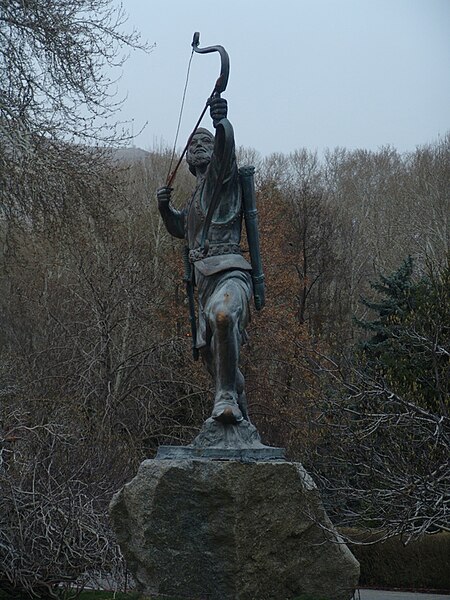Kaveh the Blacksmith is a figure in Iranian mythology who leads an uprising against a ruthless foreign ruler, Zahāk. His story is narrated in the Shahnameh, the national epic of Iran (Persia), by the 10th-century Persian poet Ferdowsi.
Illustration of Kaveh surrounded by his followers in Kaveh, a magazine from World War I that was named after him.
Kaveh the blacksmith on a stamp of the Iranian Soviet Socialist Republic, 1920, with one hand holding a hammer, and the other anachronistically waving the Republic's Red Flag.
Kurdish man in Kaveh the blacksmith costume, celebrating Newroz, in Sulaymaniyah, Kurdistan region, 2018
Iranian mythology, or Persian mythology in western term, is the body of the myths originally told by ancient Persians and other Iranian peoples and a genre of ancient Persian folklore. These stories concern the origin and nature of the world, the lives and activities of deities, heroes, and mythological creatures, and the origins and significance of the ancient Persians' own cult and ritual practices. Modern scholars study the myths to shed light on the religious and political institutions of not only present-day Iran but of the Persosphere, which includes regions of West Asia, Central Asia, South Asia, and Transcaucasia where the culture of Iran has had significant influence. Historically, these were regions long ruled by dynasties of various Iranian empires, that incorporated considerable aspects of Persian culture through extensive contact with them, or where sufficient Iranian peoples settled to still maintain communities who patronize their respective cultures. It roughly corresponds to the Iranian Plateau and its bordering plains.

Faramarz slaying Ahriman - a scene from the Shahnameh.
Detail of The School of Athens by Raphael, 1509, showing Zoroaster (left, with star-studded globe)
Chinvat Bridge scene on the sarcophagus of Wirkak.
Statue of Arash, Sa'dabad Complex.







